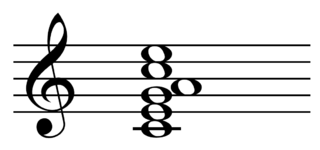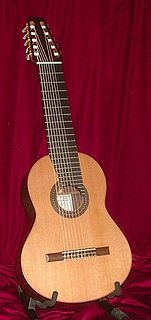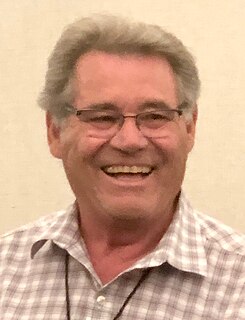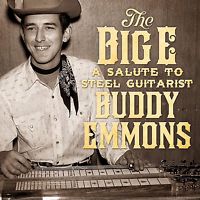
The guitar is a fretted musical instrument that typically has six strings. It is held flat against the player's body and played by strumming or plucking the strings with the dominant hand, while simultaneously pressing selected strings against frets with the fingers of the opposite hand. A plectrum or individual finger picks may be used to strike the strings. The sound of the guitar is projected either acoustically, by means of a resonant chamber on the instrument, or amplified by an electronic pickup and an amplifier.

A steel guitar is any guitar played while moving a steel bar or similar hard object against plucked strings. The bar itself is called a "steel" and is the source of the name "steel guitar". The instrument differs from a conventional guitar in that it does not use frets; conceptually, it is somewhat akin to playing a guitar with one finger. Known for its portamento capabilities, gliding smoothly over every pitch between notes, the instrument can produce a sinuous crying sound and deep vibrato emulating the human singing voice. Typically, the strings are plucked by the fingers of the dominant hand, while the steel tone bar is pressed lightly against the strings and moved by the opposite hand.

The pedal steel guitar is a console-type of steel guitar with pedals and knee levers that change the pitch of certain strings to enable playing more varied and complex music than any previous steel guitar design. Like all steel guitars, it can play unlimited glissandi and deep vibrati—characteristics it shares with the human voice. Pedal steel is most commonly associated with American country music and Hawaiian music.

The lap steel guitar, also known as a Hawaiian guitar, is a type of steel guitar without pedals that is typically played with the instrument in a horizontal position across the performer's lap. Unlike the usual manner of playing a traditional acoustic guitar, in which the performer's fingertips press the strings against frets, the pitch of a steel guitar is changed by pressing a polished steel bar against plucked strings. Though the instrument does not have frets, it displays markers that resemble them. Lap steels may differ markedly from one another in external appearance, depending on whether they are acoustic or electric, but in either case, do not have pedals, distinguishing them from pedal steel guitar.
Copedent is a term used to describe the tuning and pedal arrangement on a pedal steel guitar and is unique to that instrument. Typically expressed in the form of a table or chart, the word is a portmanteau of "chord–pedal–arrangement and is pronounced "co-PEE-dent". It was coined in 1969 by Steel Guitar Hall of Fame member Tom Bradshaw and first reached a wide audience in a 1972 article in Guitar Player magazine. A complete copedent includes the order of strings, their tuning, string gauges, and whether a string is plain or wound; it also indicates how any string's pitch is changed by applying a foot pedal or a knee lever. It has become an international standard used by steel guitar players and manufacturers to describe the specifications of these instruments.

The Gravikord is a 24 string electric double bridge-harp invented by Robert Grawi in 1984, which is closely related to both the West African kora and the mbira. It was designed to employ a separated double tonal array structure making it possible to easily play cross-rhythms in a polyrhythmic musical style in a modern electro-acoustic instrument. The Gravi-kora is a similar instrument, also developed by Grawi, which is tuned identically to a traditional 21 string kora.

The console steel guitar is any type of electric steel guitar that is built in a frame supported by legs. It may be a lap steel or a pedal steel. Console steel guitars are typically heavier instruments that have multiple necks and/or more than six strings per neck and are therefore not manageable on the player's lap. This type of instrument was created when players in the late 1940s needed to play in different keys and with different chords than the lap steel afforded. To do this, they added additional necks to a lap steel. The player could then easily switch to a different neck on the same instrument, but this made the instrument so heavy and cumbersome that it could not be easily held on the lap. Trying to solve the problem with multiple necks led to the invention of the pedal steel guitar in the 1950s.

C6 tuning is one of the most common tunings for steel guitar, both on single and multiple neck instruments. On a twin-neck, the most common set-up is C6 tuning on the near neck and E9 tuning on the far neck.

A classical guitar with additional strings is a nylon-string or gut-string classical guitar with more than six strings, in which the additional strings pass over a fingerboard so that they may be "stopped" or fretted with the fingers. These are also known as extended-range guitars, and should not be confused with harp guitars.

Doug Jernigan is an American pedal steel guitarist and Dobro player. He is known for his infusion of country music with jazz using fast single-note solos. He was one of the first steel guitarists to play solos at speeds rivaling the banjo and fiddle. Jernigan performed with Faron Young, Johnny Paycheck, Vassar Clements, Little Jimmy Dickens, and Lorrie Morgan and was a Nashville recording session musician and teacher for decades. As of 2020, he has been the featured artist on nine instrumental albums in both jazz and country genres. He was inducted into the Steel Guitar Hall of Fame in 1994.

On a stringed instrument, a break in an otherwise ascending order of string pitches is known as a re-entry. A re-entrant tuning, therefore, is a tuning where the strings are not all ordered from the lowest pitch to the highest pitch.

There are many varieties of ten-string guitar, including:

Each bass guitar tuning assigns pitches to the strings of an electric bass. Because pitches are associated with notes, bass-guitar tunings assign open notes to open strings. There are several techniques for accurately tuning the strings of an electric bass. Bass method or lesson books or videos introduce one or more tuning techniques, such as:

Buddy Gene Emmons was an American musician who is widely regarded as the world's foremost pedal steel guitarist of his day. He was inducted into the Steel Guitar Hall of Fame in 1981. Affectionately known by the nickname "Big E", Emmons' primary genre was American country music, but he also performed jazz and Western swing. He recorded with Linda Ronstadt, Gram Parsons, The Everly Brothers, The Carpenters, Jackie DeShannon, Roger Miller, Ernest Tubb, John Hartford, Little Jimmy Dickens, Ray Price, Judy Collins, George Strait, John Sebastian, and Ray Charles and was a widely sought session musician in Nashville and Los Angeles.
In playing pedal steel guitar, a universal tuning is a tuning for twelve or fourteen string instruments that combines features of several other tunings—commonly including one or both of the standard C6 and E9 tunings. Universal tunings are particularly favoured by advanced players of single-neck instruments.

Ralph Mooney was an American steel guitar player. He was inducted into the Steel Guitar Hall of Fame in 1983. He was the original steel guitarist in the Strangers.

The Fender 1000 is a model of pedal steel guitar manufactured by Fender in the 1950s and 1960s.
Zane Beverly Beck (1927–1985) was an American steel guitarist and builder of pedal steel guitars. He is best known for his 1952 innovation of adding knee levers to the pedal steel guitar to alter the pitch of certain strings, a feature which has become a standard on all modern-day instruments. Other inventors had patented crude knee-operated devices as far back as 1933, but none were successful. Beck revolutionized the concept into a durable and reliable mechanism and was the first to put knee levers on production guitars. He became a member of the International Steel Guitar Hall of Fame (1991). As a musician, he performed on the Grand Ole Opry and Shreveport's Louisiana Hayride. Beck formed the ZB Music Company which manufactures steel guitars, later called BMI.

Jimmy Day was an American steel guitarist active in the 1950s and 1960s whose career in country music blossomed about the time the pedal steel guitar was invented after pedals were added to the lap steel guitar. He was a pioneer on pedal steel in the genres of Western swing and Honky tonk and his modifications of the instrument's design have become a standard on the modern pedal steel. Day's first job after high school was performing on the Louisiana Hayride as a sideman accompanying developing country artists including Hank Williams, Webb Pierce, Willie Nelson, Jim Reeves, Ray Price and Elvis Presley. He recorded and toured with all these artists and was featured on hit records by of many of them, including Ray Price's, "Crazy Arms" and "Heartaches by the Number". He was a member of Elvis Presley's band for about a year, but, along with fellow bandmate Floyd Cramer, resigned after Presley requested them to re-locate to Hollywood; instead, Day moved to Nashville to work as a session player and Grand Ole Opry musician. He was a member of the Western Swing Hall of Fame (1994) and the International Steel Guitar Hall of Fame (1999). Day died of cancer in 1999.















